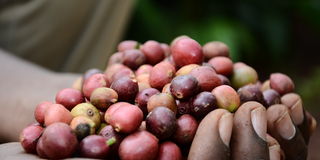Why clean seed is key to quality coffee

What you need to know:
Coffee provides income for food access and therefore plays a vital role in income and food security for better livelihood of farmers.
Uganda’s coffee production volumes are steadily increasing. Reports from the coffee regulator, the Uganda Coffee Development Authority (UCDA) show that the total coffee production over the period 2015/16 to 2019/20 increased from four million bags to 7.75 million bags, about 94 per cent increase.
The coffee roadmap has set a target of producing 20 million bags by 2030. For this vision to come to reality, it must be supported by several concerted efforts by all players along the coffee value-chain, especially improving the quality of coffee.
Coffee provides income for food access and therefore plays a vital role in income and food security for better livelihood of farmers. Coffee research experts tell Seeds of Gold why clean seed is so integral to quality coffee.
According to Dr Godfrey Sseremba, a senior research officer at the National Coffee Research Institute (NaCORI) in Mukono District, enhancing coffee quality is a collective responsibility.
‘‘Efforts for coffee quality assurance start from selection of the right varieties and quality planting materials; where steps are controlled by breeders and nursery operators under regulation of UCDA. Information on quality varieties and planting materials should be obtained from NaCORI and UCDA,’’ says Dr Sseremba.
Farmers and processors play a vital role in influencing the quality of coffee both in terms of the bean physical attributes and the cup.
‘‘Coffee quality is influenced by several factors, the majority of these are at farm level through agronomic practices. The farmer, being a gatekeeper at farm level, determines most of the coffee quality attributes that can directly and indirectly affect market prices along the entire value-chain,’’ he adds.
Why quality is key
Coffee is food; coffee is cash, and quality plays a crucial role in its value and even the taste of the coffee beverage. Farmers with blemished beans risk getting low prices for their coffee.
Quality in coffee production is influenced by a number of factors.
Clean seed
Seed is central to crop production. Farming experts often regard it as the key to progress in agriculture.
Dr Pascal Musoli, a senior research officer and coffee breeder at NaCORI, says “quality seed from good varieties guarantees good plantation establishment, good plant health with resilience to climate change effects such as pests, diseases and drought, and promotes better yield of quality coffee.”
For Robusta coffee, farmers are encouraged to grow the clones of Kituza Robusta (KR) varieties, which are resistant to coffee wilt disease. In the case of Arabica coffee, farmers in highland areas can consider planting seedlings of improved varieties such as SL14 and SL28, as superior varieties are being developed. It is important to use clean planting materials, sourced from a NaCORI or any UCDA certified nursery operator.’’
Over the years, NaCORI, has been a centre of excellence in availing good quality coffee seed, especially, of the coffee wilt resistant (CWD-r) varieties. Each year, under the Usaid FTF project, about 70,000 farmers and nursery operators are supported with Robusta coffee clones and Arabica coffee seedlings as starter-up materials for multiplication. These farmers are in different regions of the country.
Plant care
The ultimate desire of any farmer is to get a good yield from his garden. However, production challenges such as pests and diseases, climate change, unpredictable weather, among others, can reduce crop growth, yield and ultimately quality, making coffee farming strenuous and unrewarding.
According to Dr Sseremba, farmers who practice good agronomic practices such as providing appropriate shade and managing the coffee plant canopy, often get good quality coffee.
He, however, advises that the choice of shade trees to be used in the coffee plantation should be recommended by experts, such as district agricultural extension workers in your area. Research has shown that some shade trees can introduce pests in the coffee plantation because they are alternate hosts. The most commonly recommended shade tree for coffee is Albizia coriaria (Omugavu in Luganda). Other good agronomic practices for coffee include: training the coffee plant to encourage multiple stems; pruning and de-suckering, and stumping of old trees with reduced canopy size; avoiding use of synthetic herbicides as much as possible; applying more manure and less of inorganic fertilisers, and mulching to conserve soil moisture or irrigating the plantation.
Dr Sseremba adds: “to achieve an impactful effort from farmers using pro-quality agronomic practices, it is important that these farmers belong to groups or cooperatives. Group farming enables access to quality promoting technologies and improves bargaining ability for favourable prices while at the same time assures traceability of the produce.”
Some of the criteria used to measure quality in coffee include; the size of the raw bean; the shape of the bean; the bean colour, and organoleptic or cup quality. The organoleptic quality is assessed by professional coffee tasters who assess body, acidity, and flavour, among others.
Post-harvesting practices
The quest for quick cash often pushes some farmers to harvest and sell unripe coffee. Farmers are encouraged to harvest only red-ripe cherries through selective picking. After harvesting, the coffee cherries can be processed by either dry or wet processing methods. The wet method involves pulping the cherries; removing the mucilage, washing and drying the beans to get parchment. Dry processing involves drying the cherries (often under the sun), and later removing the dried husks (using a machine –huller).
“While dry and wet processing are both recognized processing methods during primary processing, the wet processing method results in better cup quality than dry processing, notes Dr Sseremba.
Advice
When drying the coffee, the area must be free from debris, stones and any other foreign matter. Raised concrete platforms or tarpaulins are recommended for use.




